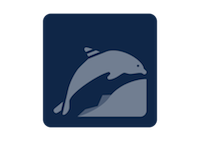The following tables compare general and technical information for a number of relational database management systems. Please see the individual products' articles for further information. Unless otherwise specified in footnotes, comparisons are based on the stable versions without any add-ons, extensions or external programs.
A time series database is a software system that is optimized for storing and serving time series through associated pairs of time(s) and value(s). In some fields, time series may be called profiles, curves, traces or trends. Several early time series databases are associated with industrial applications which could efficiently store measured values from sensory equipment, but now are used in support of a much wider range of applications.
A document-oriented database, or document store, is a computer program and data storage system designed for storing, retrieving and managing document-oriented information, also known as semi-structured data.
An embedded database system is a database management system (DBMS) which is deeply integrated with an application software; it is built into the software or an application. It is a broad term which includes:
HBase is an open-source non-relational distributed database modeled after Google's Bigtable and written in Java. It is developed as part of Apache Software Foundation's Apache Hadoop project and runs on top of HDFS or Alluxio, providing Bigtable-like capabilities for Hadoop. That is, it provides a fault-tolerant way of storing large quantities of sparse data.
MongoDB is a source-available cross-platform document-oriented database program. Classified as a NoSQL database program, MongoDB uses JSON-like documents with optional schemas. MongoDB is developed by MongoDB Inc. and current versions are licensed under the Server Side Public License (SSPL). MongoDB is a member of the MACH Alliance.
NoSQL is an approach to database design that focuses on providing a mechanism for storage and retrieval of data that is modeled in means other than the tabular relations used in relational databases. Instead of the typical tabular structure of a relational database, NoSQL databases house data within one data structure. Since this non-relational database design does not require a schema, it offers rapid scalability to manage large and typically unstructured data sets. NoSQL systems are also sometimes called "Not only SQL" to emphasize that they may support SQL-like query languages or sit alongside SQL databases in polyglot-persistent architectures.
LevelDB is an open-source on-disk key-value store written by Google fellows Jeffrey Dean and Sanjay Ghemawat. Inspired by Bigtable, LevelDB source code is hosted on GitHub under the New BSD License and has been ported to a variety of Unix-based systems, macOS, Windows, and Android.
A cloud database is a database that typically runs on a cloud computing platform and access to the database is provided as-a-service. There are two common deployment models: users can run databases on the cloud independently, using a virtual machine image, or they can purchase access to a database service, maintained by a cloud database provider. Of the databases available on the cloud, some are SQL-based and some use a NoSQL data model.

Apache Drill is an open-source software framework that supports data-intensive distributed applications for interactive analysis of large-scale datasets. Built chiefly by contributions from developers from MapR, Drill is inspired by Google's Dremel system. Drill is an Apache top-level project. Tom Shiran is the founder of the Apache Drill Project. It was designated an Apache Software Foundation top-level project in December 2016.
The Yahoo! Cloud Serving Benchmark (YCSB) is an open-source specification and program suite for evaluating retrieval and maintenance capabilities of computer programs. It is often used to compare the relative performance of NoSQL database management systems.
SequoiaDB is a multi-model NewSQL database.
Presto is a distributed query engine for big data using the SQL query language. Its architecture allows users to query data sources such as Hadoop, Cassandra, Kafka, AWS S3, Alluxio, MySQL, MongoDB and Teradata, and allows use of multiple data sources within a query. Presto is community-driven open-source software released under the Apache License.

MyRocks is open-source software developed at Facebook in order to use MySQL features with RocksDB implementations. It is based on Oracle MySQL 5.6.

DBeaver is a SQL client software application and a database administration tool. For relational databases it uses the JDBC application programming interface (API) to interact with databases via a JDBC driver. For other databases (NoSQL) it uses proprietary database drivers. It provides an editor that supports code completion and syntax highlighting. It provides a plug-in architecture that allows users to modify much of the application's behavior to provide database-specific functionality or features that are database-independent. This is a desktop application written in Java and based on Eclipse platform.
TiDB is an open-source NewSQL database that supports Hybrid Transactional and Analytical Processing (HTAP) workloads. It is MySQL compatible and can provide horizontal scalability, strong consistency, and high availability. It is developed and supported primarily by PingCAP and licensed under Apache 2.0, though it is also available as a paid product. TiDB drew its initial design inspiration from Google's Spanner and F1 papers.
An Ordered Key-Value Store (OKVS) is a type of data storage paradigm that can support multi-model database. An OKVS is an ordered mapping of bytes to bytes. It is a more powerful paradigm than Key-Value Store because OKVS allow to build higher level abstractions without the need to do full scans. An OKVS will keep the key-value pairs sorted by the key lexicographic order. OKVS systems provides different set of features and performance trade-offs. Most of them are shipped as a library without network interfaces, in order to be embedded in another process. Most OKVS support ACID guarantees. Some OKVS are distributed databases. Ordered Key-Value Store found their way into many modern database systems including NewSQL database systems.

Trino is an open-source distributed SQL query engine designed to query large data sets distributed over one or more heterogeneous data sources. Trino can query datalakes that contain open column-oriented data file formats like ORC or Parquet residing on different storage systems like HDFS, AWS S3, Google Cloud Storage, or Azure Blob Storage using the Hive and Iceberg table formats. Trino also has the ability to run federated queries that query tables in different data sources such as MySQL, PostgreSQL, Cassandra, Kafka, MongoDB and Elasticsearch. Trino is released under the Apache License.
HammerDB is an open source database benchmarking application developed by Steve Shaw. HammerDB supports databases such as Oracle, SQL Server, Db2, MySQL and MariaDB. HammerDB is written in TCL and C, and is licensed under the GPL v3.



